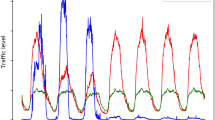Abstract
In this paper, we deal with the problem of how to design cellular networks in a cost-effective way. We first propose an optimization model that deals with selecting the location of the base station controllers (BSCs) and mobile service switching centers (MSCs), selecting their types, designing the network topology and selecting the link types. In order to find a “good” solution, we propose a tabu search algorithm. Numerical results show that the tabu search algorithm produces solutions close to a proposed lower bound.
Similar content being viewed by others
References
R. Beaubrun, S. Pierre and J. Conan, An efficient method for optimizing the assignment of cells to MSCs in PCS Networks, in: International Conference on Wireless Communications (1999) vol. 1, pp. 259–265.
P.S. Bhattacharjee, D. Saha and A. Mukherjee, Heuristics for assignment of cells to switches in a PCSN: A comparative study, in: IEEE International Conference on Personal Wireless Communications (1999) pp. 331–334.
L.A. Cox, Jr. and J.R. Sanchez, Designing least-cost survivable wireless backhaul networks, Journal of Heuristics 6(4) (2000) 525–540.
M. R. Garey and D.S. Johnson, Computers and Intractability: A Guide to the Theory of NP-Completeness (Freeman, 1979).
B. Gavish and S. Sridhar, Economic aspects of configuring cellular networks, Wireless Networks 1(1) (1995) 115–128.
F. Glover and M. Laguna, Tabu Search (Kluwer Academic Publisher, 1997).
ILOG, ILOG CPLEX 7.1—Advanced Reference Manual (2001).
R. Jonker and T. Volgenant, A shortest augmenting path algorithm for dense and sparse linear assignment problems, Computing 38(4) (1987) 325–340.
A. Merchant and B. Sengupta, Multiway graph partitioning with applications to PCS networks, IEEE INFOCOM 2 (1994) 593–600.
A. Merchant and B. Sengupta, Assignment of cells to switches in PCS networks, IEEE/ACM Transactions on Networking 3(5) (1995) 521–526.
S. Pierre and F. Houeto, A Tabu search approach for assigning cells to switches in cellular mobile networks, Computer Communications, 25(5) (2002) 465–478.
D. Saha, A. Mukherjee and P. Bhattacharjee, A simple heuristic for assignment of cell to switches in a PCS network, Wireless Personal Communication, 12 (2000) 209–224.
D. Skorin-Kapov and J. Skorin-Kapov, On Tabu search for the location of interacting hub facilities, European Journal of Operational Research 73 (1994) 502–509.
J. Sohn and S. Park, Efficient solution procedure and reduced size formulations for p-Hub location problems, European Journal of Operational Research 108 (1998) 118–126.
M.D. Yacoub, Wireless Technology: Protocols, Standards, and Techniques (CRC Press, 2002).
Author information
Authors and Affiliations
Additional information
Steven Chamberland received the Electrical Engineering degree from the École Polytechnique de Montréal in 1994 and the Ph.D. degree in Operations Research in 1998 also from the École Polytechnique. From 1998 to 1999, he was with the network architecture group of Bell Canada and from 1999 to 2001, he was a professor at the École de technologie supérieure. Since 2001, he has been an assistant professor of Computer Engineering at the École Polytechnique de Montréal. His research interests include telecommunication network planning and design and network architecture. Dr. Chamberland is a member of IEEE and ACM. E-mail: steven.chamberland@polymtl.ca
Samuel Pierre received the B.Eng. degree in Civil Engineering in 1981 from the École Polytechnique de Montréal, the B.Sc. and M.Sc. degrees in mathematics and computer science in 1984 and 1985, respectively, from the Université du Québec, the M.Sc. degree in economics in 1987 from the Université de Montréal and, the Ph.D. degree in Electrical Engineering in 1991 from the École Polytechnique de Montréal. He is currently a professor of Computer Engineering at the École Polytechnique de Montréal where he is Director of the Mobile Computing and Networking Research Laboratory and the NSERC/Ericsson Industrial Research Chair in Next- Generation Mobile Networking Systems.
Dr. Pierre is the author of four books, co-author of two books and six book chapters, as well as over 200 other technical publications including journal and proceedings papers. He received the Best Paper Award of the Ninth International Workshop in Expert Systems & their Applications (France, 1989), a Distinguished Paper Award from OPNETWORK’2003 (Washington, USA). One of these co-authored books, Télécommunications et transmission de données (Eyrolles, 1992), received special mention from Telecoms Magazine (France, 1994). His research interests include wireline and wireless networks, mobile computing, performance evaluation, artificial intelligence, and electronic learning. He is a Fellow of Engineering Institute of Canada, senior member of IEEE, a member of ACM and IEEE Communications Society. He is an Associate Editor of IEEE Communications Letters and IEEE Canadian Review. He also serves on the editorial board of Telematics and Informatics published by Elsevier Science. E-mail: samuel.pierre@polymtl.ca
Rights and permissions
About this article
Cite this article
Chamberland, S., Pierre, S. On the Design Problem of Cellular Wireless Networks. Wireless Netw 11, 489–496 (2005). https://doi.org/10.1007/s11276-005-1770-3
Issue Date:
DOI: https://doi.org/10.1007/s11276-005-1770-3




